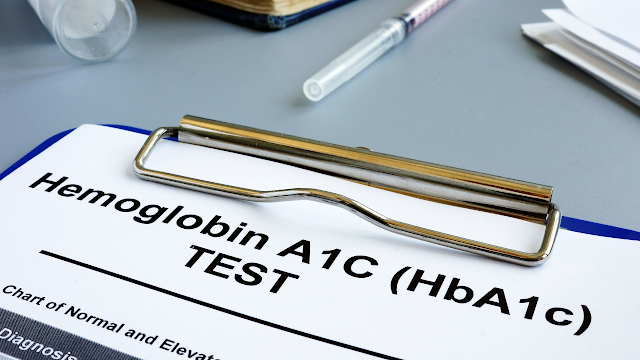Understanding the Significance of HbA1C in Diabetes Diagnosis, Reversal Monitoring, and Timing of Testing
Introduction:
In the global battle against diabetes, effective diagnostic
tools and monitoring strategies play a pivotal role. Hemoglobin A1C (HbA1C) has
emerged as a crucial parameter in this fight, serving not only as a diagnostic
tool for diabetes but also as a vital marker in monitoring the reversal of the
condition. Understanding the importance of HbA1C in both diagnosis and reversal
is essential for managing diabetes effectively and improving patient outcomes.
What is HbA1C?
HbA1C is a form of hemoglobin that is bound to glucose. It
is formed through a non-enzymatic process known as glycation, where glucose
molecules attach to hemoglobin in the blood. The level of HbA1C reflects the
average blood glucose concentration over the past two to three months,
providing a valuable indicator of long-term glycemic control.
Diagnostic Role of HbA1C:
Traditionally, the diagnosis of diabetes relied heavily on
fasting plasma glucose (FPG) and oral glucose tolerance tests (OGTT). While
these tests are still commonly used, HbA1C has gained recognition as a reliable
diagnostic tool due to several advantages it offers:
- Convenience:
Unlike FPG and OGTT, which require fasting and multiple blood samples,
HbA1C testing can be performed at any time of the day without fasting,
offering greater convenience to patients.
- Stability:
HbA1C levels are not affected by short-term fluctuations in blood glucose
levels, making them a more stable indicator of overall glycemic control.
- Long-term
Perspective: By reflecting average blood glucose levels over several
months, HbA1C provides a comprehensive view of a patient's glycemic
status, capturing both fasting and postprandial glucose levels.
Monitoring Diabetes Reversal:
In addition to its diagnostic role, HbA1C plays a crucial
role in monitoring the effectiveness of interventions aimed at diabetes
reversal. Diabetes reversal refers to the achievement of normal blood glucose
levels and metabolic parameters through lifestyle modifications, such as
dietary changes, exercise, and weight loss.
- Assessment
of Progress: Regular monitoring of HbA1C levels allows healthcare
providers to assess the effectiveness of interventions over time. A
decrease in HbA1C indicates improved glycemic control and progression
towards diabetes reversal.
- Motivational
Tool: For patients engaged in diabetes reversal programs, seeing a
decline in their HbA1C levels can serve as a powerful motivator,
reinforcing positive lifestyle changes and adherence to treatment plans.
- Prevention
of Complications: Lowering HbA1C levels is associated with a reduced
risk of diabetes-related complications, such as cardiovascular disease,
neuropathy, and retinopathy. Monitoring HbA1C levels closely helps prevent
the development and progression of these complications.
Frequency and Timing of HbA1C Testing:
The frequency of HbA1C testing depends on individual
circumstances and treatment goals:
- Diagnosis:
HbA1C testing is recommended for individuals at risk of diabetes or with
symptoms suggestive of diabetes. It can be performed at any time of the
day without fasting.
- Monitoring
for Active Diabetics: For individuals with diabetes, especially those
actively managing the condition, HbA1C should be tested monthly. This
frequency allows for close monitoring of glycemic control and timely
adjustments to treatment plans.
- Monitoring
for Diabetes Reversal: In diabetes reversal programs, HbA1C should be
monitored monthly to track progress and adjust interventions as needed.
Testing at this frequency provides a comprehensive assessment of glycemic
control and facilitates timely interventions to support reversal efforts.
Logic Behind HbA1C:
The logic behind HbA1C testing lies in its ability to
provide a comprehensive assessment of glycemic control over a prolonged period.
Unlike traditional blood glucose tests, which offer snapshots of current
glucose levels, HbA1C reflects average glucose levels over several months. This
long-term perspective is crucial for understanding overall glycemic control and
assessing the effectiveness of diabetes management and reversal strategies.
Moreover, HbA1C testing does not require fasting and is less affected by
short-term fluctuations in glucose levels, making it a convenient and reliable
tool for both patients and healthcare providers.
Conclusion:
HbA1C is a valuable tool in the diagnosis and monitoring of
diabetes, as well as in assessing the effectiveness of interventions aimed at
diabetes reversal. Its ability to provide a long-term perspective on glycemic
control makes it indispensable in clinical practice. By leveraging HbA1C
testing effectively and supplementing it with regular home-based monitoring,
healthcare providers can guide patients towards optimal management of diabetes
and improved health outcomes. Moreover, for individuals striving to reverse
diabetes, regular monitoring of HbA1C levels serves as a beacon of progress,
motivating them on their journey towards better health and well-being.


Comments
Post a Comment